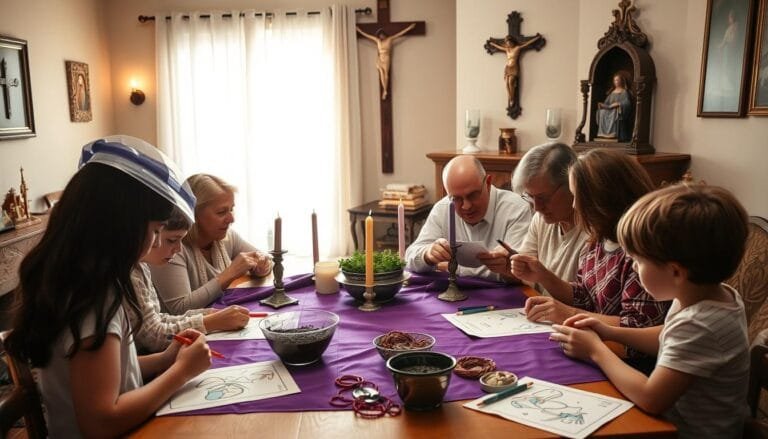Catholic Family Holiday Traditions
This website contains affiliate links. As an Amazon Associate, I earn from qualifying purchases. The content on this website was created with the help of AI.
The familiar scent of frankincense mingles with the aroma of freshly baked cookies as generations gather around the Advent wreath, a centerpiece that has illuminated December evenings for countless families across the centuries.
These cherished catholic family holiday traditions serve as spiritual anchors throughout the liturgical year, connecting modern believers to ancient practices while creating lasting memories that blend faith, culture, and community in meaningful celebration.
From St. Nicholas Day surprises to the reverent observation of the Feast of the Epiphany, these seasonal customs provide a sacred counterbalance to the increasingly commercialized holiday season.
Key Takeaways
- Christmas spans 16-22 days, ending at the Feast of the Baptism of the Lord
- Epiphany’s chalk blessings (C+ M+B +year) symbolize Christ’s presence in homes
- Advent’s Jesse Tree helps families countdown with biblical ornaments daily
- Traditional Feast days like St. Lucy’s December 13 offer cultural connection points
- The Illustrated Liturgical Year’s Christmas Cycle volume offers structured faith activities
The Sacred Rhythm: Understanding the Catholic Liturgical Calendar
Our faith grows when we connect it to time. The Catholic liturgical calendar is more than a list of dates.
It guides families to find Christ through joy, reflection, and celebration. This rhythm makes every day a chance for grace.
The Spiritual Significance of Catholic Holy Days
Each season and feast day draws us closer to God’s story. The Christmas season goes beyond December 25th to the Feast of the Baptism of the Lord.
This lets families enjoy Christ’s arrival at Mass, home altars, and meals.
Lent’s purple and Easter’s white teach us about penance and resurrection. Pentecost’s red fills our homes with prayer and Scripture.
How Holiday Traditions Strengthen Family Faith
Making Catholic holy days come alive in homes means:
- Advent wreaths with daily Scripture readings
- Epiphany cookie exchanges remembering the Magi’s gifts
- St. Joseph’s Day breakfasts in March
These traditions make faith real for kids. They can light a Christ candle or bake St. Barbara’s gingerbread. Faith becomes something they can touch and taste.
Connecting Generations Through Sacred Customs
Grandparents share Lenten fasting stories. Parents teach children to prepare Stations of the Cross. Here’s how to mix old and new traditions:
| Month | Focus | Family Activity |
|---|---|---|
| January | Holy Name of Jesus | Write prayer intentions on small crosses |
| May | Mary’s Month | Plant a garden with Marian prayers |
| November | All Saints’ Day | Decorate a family saint altar |
Every season gives a new chance to pass down faith. Living the calendar together weaves tradition that ties hearts across generations.
Preparing Hearts and Homes: Advent Traditions for Catholic Families
Advent is a time to wait with faith. Through Catholic Advent traditions, families can make everyday moments special. These practices help us stay hopeful as we wait for Christ’s birth.

Here are some easy yet powerful ways to enrich your family’s Advent journey:
- Light Advent wreaths each week. Each candle stands for a virtue: hope, peace, joy, and love. Take time to pray the Advent prayers from the Roman Missal or a kids’ Advent devotional together.
- Replace commercial calendars with ones filled with Scripture. Try a Jesse Tree—add an ornament each day to follow the story of salvation. Read a Bible story and say a simple Advent prayer together.
- Start the St. Andrew Novena. This 15-day tradition brings families together in hope. Say the prayer together at dinner or before bed.
- Decorate your home slowly. Add one decoration each week. Use purple and gold to remind us of Christ’s light during Advent.
- Collect straws for Baby Jesus. Add a straw to the manger each time your child helps or says sorry. By Christmas Eve, the manger will be full of their kindness.
These Catholic Advent traditions offer moments for quiet thought. Even lighting the Advent wreaths weekly can anchor your family’s Advent celebration in Christ’s coming.
Pick what works for you and watch your faith grow in small, steady steps.
Celebrating the Nativity: Christmas Traditions That Honor Christ’s Birth
At the heart of Catholic Christmas traditions is the joy of remembering Jesus’ birth. Families can celebrate through rituals focusing on prayer, community, and Scripture.
On Christmas Eve, we really try to stress that Christmas is about Jesus’ birthday. This year, we baked him a cake to remind the kids who the real reason for the season is.
Start the evening with religious Christmas celebrations like Midnight Mass. Families gather to hear the Nativity story. Then, light a Christ candle and read Luke 2 together.
Some families bless their homes with holy water. This invokes God’s presence throughout the season.
Make the joy of Christ-centered Christmas last beyond December 25th. The twelve days of Christmas end on Epiphany (January 6), celebrating the Magi’s journey.
Create a “journey” by moving nativity figures closer to the manger daily. On Epiphany, share a King’s Cake and talk about the gifts of gold, frankincense, and myrrh.
- Bake a birthday cake for Jesus as a family activity
- Hold a family rosary with Joyful Mysteries on Christmas Eve
- Read the Christmas Proclamation (Luke 2) at dawn
Prayerful moments ground the season. Say a blessing over the gifts before unwrapping them: “Bless these gifts, Lord, that they may remind us of your greatest gift, Jesus.”
| Feast | Date | Tradition |
|---|---|---|
| Feast of the Holy Family | Dec 26 | Reflect on family unity through Scripture |
| Solemnity of Mary | Jan 1 | Light a Mary candle and read Luke 1:42 |
| Epiphany | Jan 6 | Exchange small gifts symbolizing the Magi’s offerings |
These practices help us pass on the faith. Like the tradition of the Christ-centered Christmas manger scene, add a new ornament each day until Jesus is placed in the creche at midnight.
Lenten Practices That Bring Families Closer to Christ
Catholic Lent traditions are a time for renewal. They help families grow closer to Christ through sacrifice and prayer.
The 40 days of Lent are a chance to simplify, deepen faith, and prepare for Easter.
Start with sacrifices that fit each family member’s age. Young kids might give up screen time or do small acts of kindness.
Teens can fast from social media or help out weekly. Use a sacrifice jar to track good deeds.
Pair these actions with family prayers like the Stations of the Cross or the Divine Mercy Chaplet. The Monthly Liturgical Membership has 190+ pages of Lenten resources to help plan.

| Day | Practice |
|---|---|
| Palm Sunday | Make palm crosses from last year’s palms |
| Maundy Thursday | Hold a foot-washing ceremony |
| Good Friday | 3pm family silence at Calvary’s hour |
| Holy Saturday | Prepare Easter Vigil baskets with candles and bread |
Adapt Family Stations of the Cross at home. Use picture books, backyard paths, or parish visits.
For Holy Week, try Meredith Gould’s Last Supper as a Seder service. This can deepen your understanding of Christ’s last meal.
Pair these practices with almsgiving. Donate pantry items daily to serve others. Let Lent be a time of unity.
Families grow closer to Christ and strengthen their faith by sharing sacrifices, prayers, and service.
Resurrection Joy: Easter Traditions Beyond the Bunny
Many Catholic families face the challenge of mixing secular Easter symbols with the sacred. Did you know that 70% of households blend religious and modern customs?
Let’s focus on Christ’s victory through traditions that deepen faith and bring family joy.
Start Holy Week with the Easter Vigil, the “mother of all liturgies.” Families light Pascal candles and renew baptismal promises. This ritual reminds us of Easter’s core message: “Christ is risen!”
“The Resurrection of Jesus is the foundation of our faith.”
Try these Catholic Easter traditions to keep the season centered on Christ:
- Host a Resurrection Breakfast with foods like lamb-shaped bread, red eggs, and lilies
- Read the resurrection story from children’s Bibles during meals
- Bless family baskets with a simple prayer: “Bless these gifts, Lord, that they may remind us of Your love”
Continue celebrating through the Easter Octave (the eight days after Easter Sunday):)
| Day | Tradition | Symbolism |
|---|---|---|
| Day 1 (Easter Sunday) | Family Mass attendance | Communal witness of faith |
| Day 3 | Divine Mercy prayers | Emphasis on God’s mercy |
| Days 4–8 | Weekly Resurrection Rolls baking | Baking time as prayer time |
Over 60% of families use Resurrection Eggs to teach children the story. Let the 50-day Easter season inspire weekly acts of kindness and family Scripture readings.
By focusing on religious Easter celebrations, we help children see Easter as a season of joyful faith discovery, not just a day of eggs and bunnies.
Catholic Family Holiday Traditions That Nurture Faith Year-Round
Let faith grow through Catholic family feast days and saints’ feast day celebrations.
Families who honor saints’ days find vibrant ways to connect with the communion of saints. Here are some simple steps:
- Choose a patron saint for your family—St. Joseph for workers or St. Teresa of Calcutta for service.
- Cook traditional dishes: Mexican families might make tamales for St. Anthony’s feast (June 13) or Irish soda bread on St. Brigid’s Day (Feb 1).
- Read saints’ stories and pray their novenas together.
Incorporate cultural Catholic traditions like Poland’s Fasnacht cookies before Lent or Italian Feast of the Assumption processions.
These rituals make faith real. Pope Francis says: “Traditions are living bridges to the heart of the Gospel.”
“When families sing hymns like “Tantum Ergo” or “Pange Lingua,” faith becomes a shared melody.”
Here are practices for different age groups:
- 6–24 Months: Sing simple chants during meals.
- 3–6 Years: Act out Nativity scenes or St. Nicholas stories.
- 6–12 Years: Attend parish festivals like Las Posadas or Misa del Gallo.
- Teens 13+: Plan service projects for St. Vincent de Paul’s feast (July 27) or compose original prayers for family altars.
Remember, 85% of families see traditions as key to faith growth. Check out the Catechist’s guide for more ideas. Let every season be a time to grow closer to God together.
Conclusion: Weaving Faith, Family, and Tradition Into a Sacred Tapestry
Catholic family traditions are more than just customs. They connect us to God and each other.
Lighting Advent wreaths or blessing herbs on August 15 ties us to the Church’s timeless rhythms.
Teaching faith through holidays helps kids understand important truths like the Sacrament of Marriage and Lenten sacrifices.
Start with small steps, like adding one new tradition each year. Let your family’s stage shape your practices, like Epiphany gift-giving.
Remember, it’s okay to make mistakes. Even simple prayers at Christmas or fasting on Ash Wednesday matter.
Passing down faith traditions honors our ancestors and meets today’s needs. Celebrating saints’ feast days or adding modern twists to Easter strengthens your family’s faith.
Books like Restoring Lost Customs of Christendom can guide you, but your family’s creativity is key.
These practices create a sacred tapestry that reminds us faith is lived, not just believed. As seasons change, may your traditions anchor your children’s souls.
May the Lord bless your efforts to create a Catholic family culture, for He is made known in these rituals.








